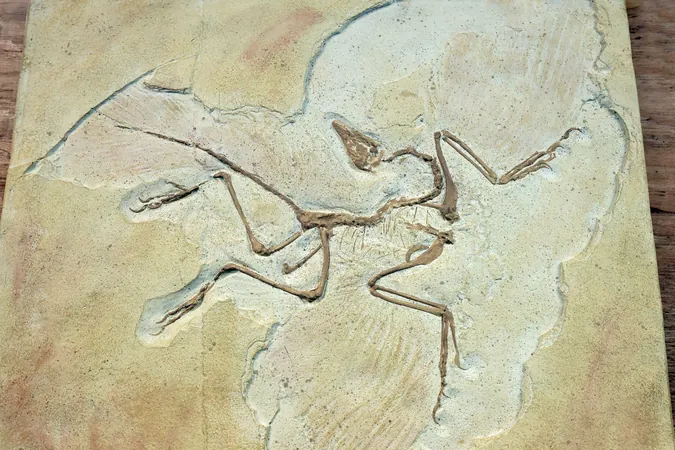
Unearthed Fossil from Dinosaur Age Could Unlock Secrets to Bird Intelligence Evolution!
2024-11-13
Author: Sarah
Groundbreaking Fossil Discovery
A groundbreaking fossil discovery could reshape our comprehension of avian intelligence and the unique brain structures of modern birds, one of the persistent enigmas of vertebrate evolution.
Remarkably Preserved Fossil Bird
Researchers have unveiled a remarkably preserved fossil bird, about the size of a starling, dating back to the Mesozoic Era. This near-complete skull is a rare find in paleontology, particularly given its age, marking it as one of the most pivotal discoveries in the field.
Research Collaboration
Under the leadership of the University of Cambridge in collaboration with the Natural History Museum of Los Angeles County, scientists have digitally reconstructed the three-dimensional brain of this ancient bird, now named Navaornis hestiae, which lived around 80 million years ago in what is presently Brazil—just before the mass extinction event that annihilated non-avian dinosaurs.
A Rosetta Stone for Avian Brain Evolution
The research, published in the esteemed journal Nature, posits that this fossil represents a "Rosetta Stone" for deciphering the evolutionary origins of the avian brain. Navaornis fills a staggering 70-million-year void in our grasp of avian brain evolution, bridging the gap between the primitive Archaeopteryx, the earliest known bird-like dinosaur from approximately 150 million years ago, and today's numerous bird species.
Cerebrum and Cerebellum Analysis
Intriguingly, the skull of Navaornis exhibits a larger cerebrum compared to Archaeopteryx, indicating potential advancements in cognitive functions. Nevertheless, its cerebellum—a region responsible for flight control—remains relatively underdeveloped, implying that Navaornis had not yet achieved the complex flight dynamics of modern avian species.
Comments from Researchers
Dr. Guillermo Navalón, co-lead author from Cambridge's Department of Earth Sciences, remarked, "The brain structure of Navaornis is almost perfectly situated between Archaeopteryx and contemporary birds—it's like completing a puzzle with a missing piece that fits seamlessly."
Navaornis Discovery
Navaornis is named in honor of William Nava, who discovered the fossil in 2016 at a site in São Paulo State. Millions of years ago, this locale was likely a dry area with slow-flowing creeks, conducive to exceptional fossil preservation.
Advanced Micro-CT Scanning Technology
Utilizing advanced micro-CT scanning technology, the team reconstructed the bird's skull and brain in spectacular detail. Professor Daniel Field, senior author of the study, commented on modern birds, stating, "They possess some of the most sophisticated cognitive abilities among animals, rivaled only by mammals. But it has been a challenge to pinpoint how their remarkable intelligence evolved. This discovery is a crucial piece that many in the field have been anticipating."
Void in Understanding
Before this, our understanding of the evolutionary transition between Archaeopteryx and modern birds was virtually nonexistent. Navalón adds, "This discovery encapsulates nearly 70 million years of avian evolution, marking the inception of major lineages of Mesozoic birds, including the ancestors of today's species."
Enantiornithines Group
While initially resembling a small pigeon, upon closer examination, experts determined that Navaornis belongs to an early bird group known as enantiornithines, or "opposite birds." Contrastingly, these enantiornithines diverged from modern birds over 130 million years ago yet shared complex feather structures and likely possessed flight capabilities akin to contemporary avians. The question now arises: How did these opposite birds manage flight without the advanced brain features—like an expanded cerebellum—seen in living birds?
Evolutionary Development of Bird Cognition
"This fossil exemplifies a crucial stage in the evolutionary development of bird cognition," Field emphasized. The cognitive capabilities of Navaornis may have provided advantages in food acquisition, shelter exploration, and possibly intricate mating displays or social interactions.
Modern Skull Structure
Dr. Luis Chiappe further noted, "Interestingly, some birds that soared over dinosaurs had developed a fully modern skull structure more than 80 million years ago."
Future Discoveries
Though Navaornis remains one of the most impeccably preserved bird fossils from the Mesozoic Era, researchers believe even more significant discoveries could arise from the Brazilian site where it was found, potentially enriching our understanding of bird evolution.
Summary of Its Significance
"This fossil is just one segment in the intricate narrative of bird brain evolution," summarised Field. "With Navaornis, we gain clearer insights into the transitions that occurred between Archaeopteryx and today's intelligent, behaviorally intricate birds, like crows and parrots. This discovery is merely the first step; future research could unveil how Navaornis interacted with its environment, expanding our understanding of avian cognition through the ages."
Ongoing Research Efforts
The unveiling of Navaornis is part of an ongoing effort by Field's group, which has described several Mesozoic fossil birds, including the likes of Ichthyornis, Asteriornis (the "Wonderchicken"), and Janavis since 2018. Their innovative approaches combining new fossil finds with cutting-edge visualization techniques have unearthed fundamental truths regarding the origins of birds—an incredibly diverse group of vertebrates in today's ecosystem.




 Brasil (PT)
Brasil (PT)
 Canada (EN)
Canada (EN)
 Chile (ES)
Chile (ES)
 Česko (CS)
Česko (CS)
 대한민국 (KO)
대한민국 (KO)
 España (ES)
España (ES)
 France (FR)
France (FR)
 Hong Kong (EN)
Hong Kong (EN)
 Italia (IT)
Italia (IT)
 日本 (JA)
日本 (JA)
 Magyarország (HU)
Magyarország (HU)
 Norge (NO)
Norge (NO)
 Polska (PL)
Polska (PL)
 Schweiz (DE)
Schweiz (DE)
 Singapore (EN)
Singapore (EN)
 Sverige (SV)
Sverige (SV)
 Suomi (FI)
Suomi (FI)
 Türkiye (TR)
Türkiye (TR)
 الإمارات العربية المتحدة (AR)
الإمارات العربية المتحدة (AR)